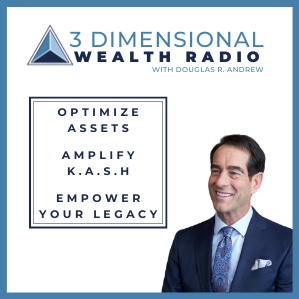Do you know what GAP means? Are you familiar with how IUL index strategies work? Understanding these terms can help you unlock a brighter financial future, so read on…
It’s no secret my favorite financial vehicle is a properly structured, maximum-funded Indexed Universal Life policy. It provides unparalleled liquidity, safety, predictable rates of return, and tax advantages, and it can make a significant difference in your life as part of your financial portfolio.
But how exactly does IUL work? And why is it so safe and effective? To explore these topics, let’s define a couple important terms: GAP and index strategies.
In my book “The LASER Fund,” which I co-wrote with my sons, Emron and Aaron, we explain how indexing works, giving you a peek behind the scenes to see how insurers can give you all the upside benefits of the market while protecting you from the downsides.
DEFINING THE GAP
Let’s say you have $1 million set aside in a properly structured IUL policy, or what I call a LASER Fund. The insurance company puts your $1 million into its General Account Portfolio (GAP). There, the lion’s share of that money is in safe, conservative investments like AAA and AA bonds with typically stable rates of return. Let’s say in this example, out of your $1 million, the insurance company puts $960,000 into the GAP.
This money is going to grow back up to $1 million during the year, which essentially guarantees your principal of $1 million. This growth is due to the GAP earning a fixed rate of return (currently 4% to 4.5%), regardless of market performance. How is this possible? Because as we just mentioned, the $960,000 is invested in safe, conservative investments that offer fixed annual rates.
The only portion of your money that is “at risk” is the remaining $40,000. The insurance company takes that $40,000 of your $1 million to buy options based on the index strategy you have chosen. Options
may be risky, but remember your policy’s cash value policy has guarantees and your cash value is not at risk. Insurance companies can do this, because they are only putting the $40,000 into options, not the other $960,000.
Options are complex, so let’s look at a simplified explanation here, examining what could happen to that $40,000 in different scenarios. Let’s say for your index strategies, you have chosen a one-year low volatility index with no cap and a 125% participation rate. If this index goes up 10% over the next year, you would get 12.5% (which is 125% of 10%). With the option strategy, after one year, your $40,000 grows to $125,000, which is a 12.5% return on your $1 million.
Now let’s say the index goes down 10%. With the way the options work, the $40,000 is lost, but your $1 million doesn’t go down 10%. Even if the index were to drop precipitously, say 40%, the options are still worthless—the $40,000 is gone—but you don’t lose any of your $1 million principal in cash value. Your $1 million principal is guaranteed a 0% floor because of the GAP.
Now you may be wondering, why can caps and participation rates vary from year to year? The insurance company sets the cap/participation rate based on variables like their options costs and the rate they’re earning on the GAP. If interest rates in America are going up and the GAP is set to earn more this year, they will likely put less (like $950,000) of your cash value into the GAP, put more (like $50,000) to work in options, and raise the cap/participation rate slightly for the year—because they are likely to get stable returns in the GAP.
As a reminder, caps and participation rates can go down, and they can go up. As market conditions (like interest rates and the cost of options) change, you’ll often see related changes to caps and participation rates. And remember, it’s advantageous that you’re not locked in, because if interest rates rise, your caps and participation rates can eventually rise as well (that change can take a few years).
THE POWER OF INDEX STRATEGIES
You’ll notice above I mentioned specific index strategies. What do I mean by this? When we talk about indexes, we’re talking about things like the S&P 500, the Dow Jones, the Russell 2000. With properly structured IUL policies, you can choose index strategies that LINK TO market indexes, without actually putting your money at risk IN the market.
Let’s look at an illustration to explain. One of my favorite indexes for IUL index strategies is the S&P 500. Let’s say it’s November 15, 2011, and I link my $1 million IUL policy to the S&P 500. I’m guessing it’s going to be an up-year for the market, because we’re headed into a presidential election year. A year later, on November 15, 2012, let’s say the S&P 500 increased by 10%. The insurance company is contractually obligated to pay me that increase of 10%. So my policy accumulation value grows by $100,000.
But what if I guessed wrong and the market tanked, like it did in 2008 when most Americans with money IN the market lost 40% of their IRA and 401(k) account values? I wouldn’t be worried, because my policy would still be protected by a 0% guaranteed floor.
Looking at recent history, between 2000 and 2010 (which proved to be the worst decade for the market since the Great Depression), the market experienced five down years and five up years, and in that time, the average return was 7.23%.
During the down years, folks like me with money safely tucked inside LASER Funds didn’t lose a dime to market volatility. During those five up years, I earned significantly, and I only capped out twice. By using three different index strategies over that decade, I did better than most–I averaged 9.62%.
For even more on index strategies, see my article, “What Is Indexed Universal Life–and How Does it Work?”, but in summary here, indexing allows the money in your policy to gain interest when the stock market goes up, and to be completely protected from losses due to market volatility when the market goes down. Depending on your insurance company, you can choose from among several different index strategies, including S&P 500 and low volatility index accounts. You can also choose among strategies like the one-year point-to-point, two-year point-to-point, and five-year point-to-last-year-average.
You have the flexibility to make choices that work for you, such as whether to leave your selected index strategies as your default, or to change it up to accommodate shifts in the market like I did. Your IUL specialist can help you optimize your LASER Fund strategies.
WANT TO LEARN MORE?
Watch the Video – Watch the related YouTube video to see me explain “How Indexed Universal Life Insurance Works” (and while you’re there, be sure to subscribe to my YouTube channel so you don’t miss a thing!).
Elevate Your Financial Dimension – Find out how you can improve your Financial Dimension journey and seize the liquidity, safety, predictable rates of return, and tax advantages of a LASER Fund. Explore the in-depth financial strategies and learn from real-life client experiences by claiming your free copy of “The LASER Fund” book at LASERFund.com. Just pay for shipping and handling, and we will send it to you, absolutely free.
Join a Webinar – Want to find out if a LASER Fund (a maximum-funded, properly structured indexed universal life insurance policy) is right for you? Join us for an upcoming webinar where you can explore these strategies.


